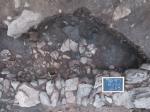Summary (English)
This was the first campaign of excavations undertaken on the site of Cuccureddus at Villasimius (CA) by the University of Sassari in collaboration with the local administration and archaeology museum. These are the first investigations in the area since the excavations undertaken in the second half of the 1980s by Luisa Anna Marras.
This intervention uncovered several intact parts of the rectangular rooms originally excavated in the 1980s and the overall stratigraphy of the area made it possible to recover data relating to the Phoenician occupation phase, with the presence of transport amphora and other pottery, but above all to identify a series of collapse layers which seal these rooms overlooking the sea. The cleaning of the summit plateau made it possible to revise and update the plan of the area, ascertaining the existence of an imposing wall c. 3 m wide surrounding the top of the lowest hill at Cuccureddus, at the almost constant level of c. 62 m a.s.l. The 2017 investigations showed the great possibility of the site, in terms of useful elements for the reconstruction of the diachronic occupation of this sector of south-eastern Sardinia, with specific reference to the Phoenician phases. The excavations, although involving a small part of the site and within previously identified structures, confirmed the area’s overall chronology.
The earliest documented activities were represented by quarry cuts and the construction of small rooms abutting a part of the external wall (not found as obliterated by a later rebuild) during the middle Phoenician period, between the late 7th century and the early 6th century B.C. The archaic phase is widely attested but for a reduced period that ends in the second half of the 6th century B. C. In the upper levels of the collapsed Phoenician structures that were raised and levelled, there were layers of fill relating to a first reorganisation of the area during the Roman Republican period (3rd-2nd to 1st century B.C.).The Hellenistic-Roman levels must have been substantially altered during the early imperial period, when there is an increase in evidence, datable to between the 1st and 3rd centuries A.D. until the final occupation horizons dating to the 4th or early 5th centuries A.D. At present, the imperial period is documented by the finds contained in the levels of terrain artificially cut and re-compacted by mechanical diggers during an intervention to flatten the top of the Cuccureddus hill in the 1970s.
- Michele Guirguis - Università degli Studi di Sassari
Director
- Michele Guirguis - Università degli Studi di Sassari
Team
- Elisabetta Gaudina - Museo Archeologico di Villasimius
- Ernesto Amedeo Insinna - Università degli Studi di Sassari
- Rosana Pla Orquín - Università degli Studi di Sassari
Research Body
- Dipartimento di Storia, Scienze dell’Uomo e della Formazione dell’Università degli Studi di Sassari
- Soprintendenza Archeologia, Belle Arti e Paesaggio per la città metropolitana di Cagliari e per le province di Oristano, Medio Campidano, Carbonia-Iglesias, Ogliastra - Area funzionale Patrimonio Archeologico
Funding Body
- Comune di Villasimius
- Dipartimento di Storia, Scienze dell’Uomo e della Formazione dell’Università degli Studi di Sassari
- Museo Archeologico di Villasimius






![Download [PDF]](/excavation/skins/fasti/images/results/download_sml.png)